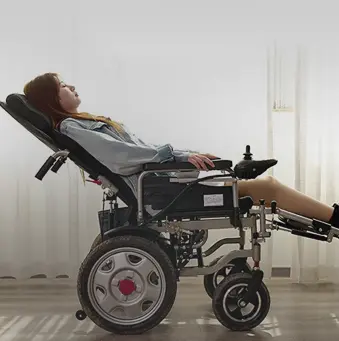Introduce
Electric wheelchairs have changed the lives of millions of people, providing mobility and independence to people with disabilities. This extraordinary invention is the result of decades of innovation, engineering and advocacy. In this blog, we’ll explore the history of electric wheelchairs, tracing their evolution from early manual designs to the complex electric models we see today.
Early Start: Manual Wheelchair
The birth of wheelchair
The concept of wheelchairs dates back to ancient times. The earliest known wheelchair was made in the sixth century for King Philip II of Spain. The device was a simple wooden chair mounted on wheels to allow the king to move around more easily. Over the centuries, wheelchairs have evolved and their designs have become more complex. In the 19th century, the first folding wheelchair came out, making transportation more convenient.
Limitations of manual wheelchairs
While manual wheelchairs provide mobility, they require a lot of upper body strength and endurance. These wheelchairs are often insufficient for people with limited strength or mobility. The need for a more convenient solution became increasingly apparent, setting the stage for the development of electric wheelchairs.
The birth of electric wheelchair
The 20th Century: The Age of Innovation
The early 20th century was a period of rapid technological development. The invention of the electric motor opened up new possibilities for mobile devices. The first electric wheelchair prototypes began to appear in the 1930s, primarily for people with disabilities caused by polio and other diseases.
The first electric wheelchair
In 1952, Canadian inventor George Klein developed the first electric wheelchair, known as the “Klein Electric Wheelchair.” This groundbreaking design uses battery-powered motors and steering joysticks. Klein’s invention was a major leap forward, providing users with greater independence and mobility.
Advances in design and technology
The 1960s and 1970s: Refinement and Popularization
As power wheelchairs became more popular, manufacturers began to improve their designs. The introduction of lightweight materials such as aluminum and plastic has made power wheelchairs more portable and easier to maneuver. Additionally, advances in battery technology allow for longer usage times and faster charging.
The rise of customization
By the 1970s, power wheelchairs became more customizable. Users can choose from a variety of features, including adjustable seats, tilt and tilt options, and specialized controls. This customization allows individuals to customize the wheelchair to their specific needs, improving comfort and usability.
The role of advocacy and legislation
Disability Rights Movement
The 1960s and 1970s also saw the emergence of the disability rights movement, which advocated for greater accessibility and inclusion for people with disabilities. Activists fight for legislation that ensures equal rights and access to public space, education and employment.
Rehabilitation Act of 1973
One of the landmark pieces of legislation was the Rehabilitation Act of 1973, which prohibited discrimination against people with disabilities in federally funded programs. The bill paves the way for increased funding for assistive technologies, including power wheelchairs, making them more accessible to those who need them.
The 1980s and 1990s: Technological Breakthroughs
Microprocessor Technology
The introduction of microprocessor technology in the 1980s revolutionized power wheelchairs. These advances allow for more sophisticated control systems, allowing users to maneuver their wheelchairs with greater precision. Features like speed control, obstacle detection and programmable settings come standard.
The emergence of power assist devices
During this time, power assist devices were also developed to allow users of manual wheelchairs to benefit from electric power assistance. These devices can be attached to existing wheelchairs to provide additional power when needed.
21st Century: Intelligent Technology and the Future
Integration of intelligent technology
Entering the 21st century, electric wheelchairs have begun to incorporate smart technology. Features such as Bluetooth connectivity, smartphone apps and a GPS navigation system are available, allowing users to remotely control the wheelchair and access real-time information about their surroundings.
The rise of autonomous wheelchairs
Recent advances in robotics and artificial intelligence have spurred the development of autonomous electric wheelchairs. These innovative devices can navigate complex environments, avoid obstacles, and even transport users to specific locations without manual input. Although still in the experimental stage, these technologies hold great promise for the future of mobility.
Impact of electric wheelchairs on society
Enhance independence
Electric wheelchairs have had a profound impact on the lives of disabled people. By providing greater mobility and independence, these devices enable users to participate more fully in society. Many people who once relied on caregivers for transportation can now navigate their environment independently.
Changing perspectives on disability
The widespread use of electric wheelchairs is also helping to change people’s perceptions of disability. As more people with disabilities become active participants in their communities, social attitudes shift, leading to greater acceptance and inclusion.
Challenges and future directions
Accessibility and Affordability
Despite advances in power wheelchair technology, challenges remain. Accessibility and affordability remain significant barriers for many people. Although insurance coverage for power wheelchairs has improved, many users still face high out-of-pocket costs.
The need for continuous innovation
With the continuous development of technology, electric wheelchair design urgently needs continuous innovation. Future developments should focus on enhancing user experience, extending battery life and integrating advanced security features.
in conclusion
The history of electric wheelchairs is a testament to human ingenuity and the relentless pursuit of independence by people with disabilities. From its humble beginnings to the sophisticated devices it is today, electric wheelchairs have changed people’s lives and reshaped society’s view of disability. Going forward, continued innovation and advocacy will be critical to ensuring that power wheelchairs are accessible and affordable to all who need them. The power wheelchair’s journey is far from over and its impact will undoubtedly continue to be felt for generations to come.
Post time: Oct-25-2024


